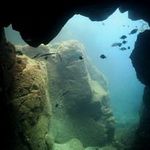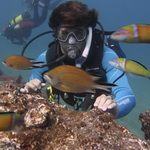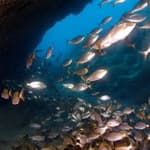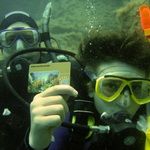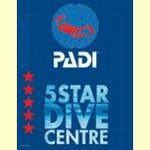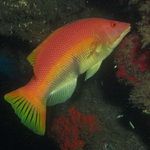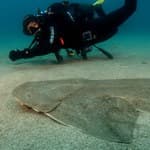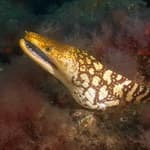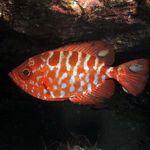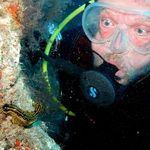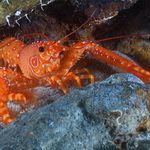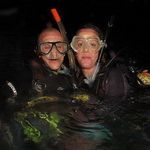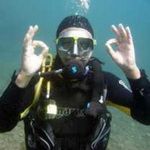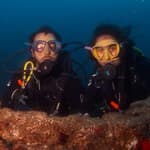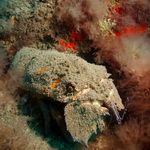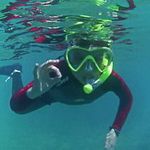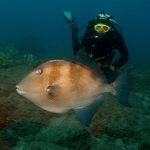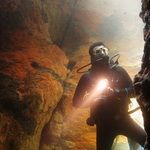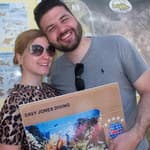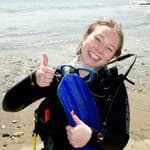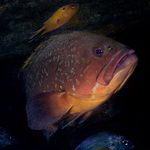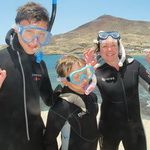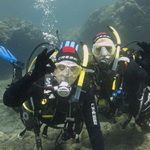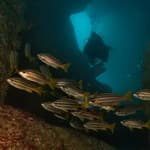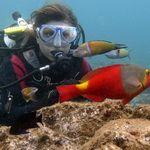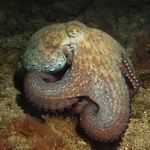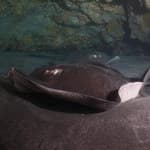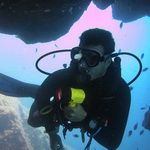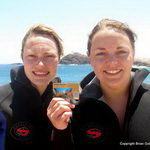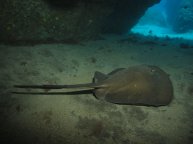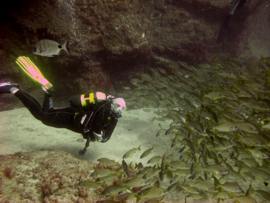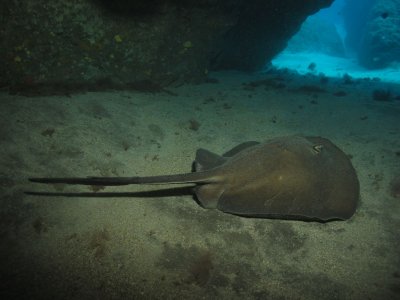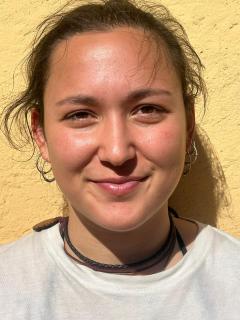Dykplatser i El Cabron Marine Reserve (Arinaga) Gran Canaria
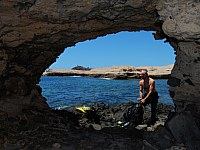

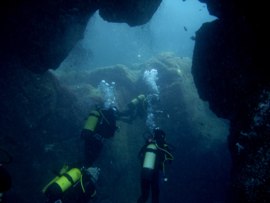
Här är en kort smakprov på vad du kan förvänta dig att hitta i el Cabrón. Vi tar en snabb titt på våra mest populära dykplatser i Marine Reservatet.
- The Hole in the Wall
- The Table Top
- Punta de la Sal
- Punta de la Monja
- Discovery Bay
- Risco Verde
Sammanlagt finns det över 12 olika dyk vägar och start punkter i reservatet, tillräckligt för att kunna dyka här i över en vecka. Vi är ett av de få dykcenter som tar kunder till dykplatser som Cal Steps, Get spåret, Muelle Vieja eller Mån Revet. Vår ingående kunskap om området innebär att vi kan dyka säkert här. Några av de vanligaste dykpunkterna stängs av vid onormala vindriktningar. Vår skola är det närmaste dykcentret till reservatet. Erfarenheten av dykning här i över sju år och instruktörer som bor vid stranden i Arinaga (som lärt sej varje humörsvängning i havet), innebär att vi känner till området bättre än någon annan dykskola på Gran Canaria! Tillsammans har vi väldigt roligt; utmanande dykning och exeptionell säkerhet, gör Davy Jones Diving ditt första val för dykning i El Cabrón Marine Reserve på Gran Canaria
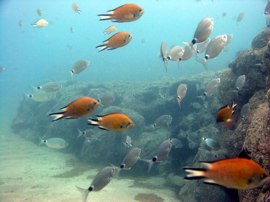
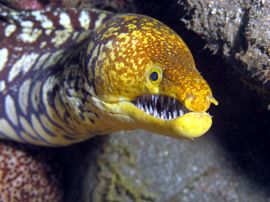
The Hole in the Wall

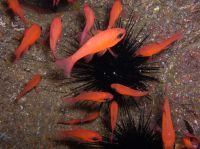
This is not only the most spectacular, but also a more challenging dive, and can only be attempted when the winds and currents are favourable
The dive begins with an entry from a reef into a vee-shaped channel with a depth of about 5 meters; we then descend to 14 meters by swimming down through a hole,and out through the cave that gives the site it's name.
Swim down the slope for 25 metres and you are then greeted by the amazing sight of a large archway filled with Trumpet Fish and Bream, following a slope that quickly drops down to a maximum depth of 24 meters.
If you have not yet been amazed by the diversity of life on this dive, swim on for another 100 metres and the sight of around two thousand bastard grunts (or roncadores) in a large 'fish ball' confronts you. There is also a school of Striped Bream with the ever present Barracudas in search of a quick snack. The Barracudas can grow up to 1.2 meters long and are at the top of the food chain here.
You are also likely to see Eagle Rays, Morays, Marble electric Rays and Common Sting Rays as well as the occasional Angel Shark. Common fish include bream, grouper, nudibrachs and many of the other common Canarian species. There are also two caves on this dive, and divers with good air consumption and appropriate qualifications can be taken here to see rarer species such as forkbeard, leopord spotted goby, canarian lobsterette, prickly shrimp and yellow coral.
This is rated as a favourite site by those lucky enough to get the right conditions to attempt it.
The Table Top


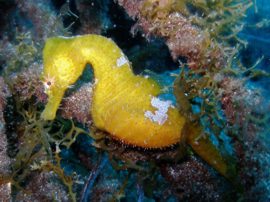
From this entry point there are several classic dive routes, including the Fish Ball, The Finger, Arco Pequeno, The eel garden and The Table Top itself. The entry point for this dive can look daunting at first, as the waves can often appear to break right on the entry point. A special entry technique, an underwater channel and the combination of currents make this a lot easier that it may first look. The diver is rewarded with a variety of dive plans, taking him to the Fish Ball, or to the caves and swim-throughs. Fish life is abundant in this area, and apart from the common species of parrotfish, damsels, wrasse, and bream, you are likely to find yellow snappers (roncadors), trumpetfish, a shoal of barracudas, plenty of morays (tiger, brown and dotted), cernia rossa, and in spring large shoals of sardines and bogas. Several species which are less common have resident populations in this are including Shi Drum (verrugato), glasseye, marmor bream, jurel (yellow jack), painted comber, zebra bream and some stunning giant anemones. If you look carefully or just get lucky you may also see dusky grouper, three types of stingray, forkbeard, unicorn fish, tuna or in exceptional circumstances sea-horse, blue sharks or manta rays. A night dive can reward the adventurous with stingrays, squid, octopus, angelshark and many other night hunters of the reef. And as for plant life and invertebrates there is much more to look at here as well.
In addition to the prolific marine life, there is a fascinating underwater scenery, allowing 'wall dives' around much of the outside of the reef; several caves, the small arch and lots of larger holes to look in for morays and other creatures.
Few dive sites in the Canaries have such variety, such abundance, and such scenery so
close in to the shore all available from one shore entry point.
Punta de la Sal
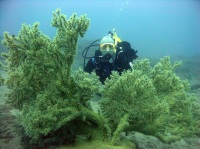
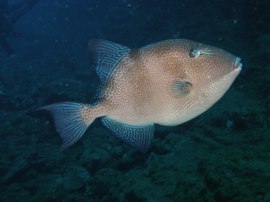
There are two ways to reach this area, which is the deepest part of the reserve. We normally use the 'Table Top' entry point as this is less prone to the effect of a northerly wind.
This is not only a deep dive, but also a long dive, so is only suitable for experienced divers who can demonstrate similar previous experience, as we normally plan this as a decompression dive.
We start by following the undersea cliff at a level of 10-15m. In clear conditions this area can hold tuna, barracuda, trumpetfish and grouper. We descend slowly, passing a field of garden eels on our right, till we reach an area of large boulders, in around 20m,where large numbers of morays can usually be found.
Continuing on from this point, we reach the 'campo de gorgonia' in 30m where you can see these delicate gorgonians. There is one particular gorgonian which is over 2m wide.
In this deeper area other species such as marbled-electric rays, gilt-headed bream and angelshark have also been seen.
Punta de la Monja
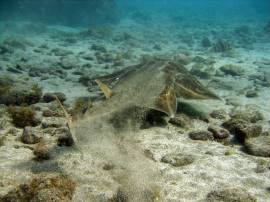
Genom att utgå från inkörsporten "Hole in the Wall" kan du simma hela vägen runt spetsen på den punkt Punta de la Monja, och avsluta dyket i lugnare vatten El Cabrón Bay. Detta är en mycket lång dyk, och noggrann luftförbrukningen är ett måste. Detta är en mycket lång dyk, och noggrann luftförbrukningen är ett måste. Det finns flera små grottor och stora urtag i klipporna där mer nattaktiva arter såsom glas-ögon, och Conger kan hittas under dagen. Stora stim av atlantisk Frökenfisk bebor klippor och avsatser vilket gör topografin mycket dramatiska här.
Risco Verde

Risco Verde (eller gröna Klippan) är närmast dykplatsen till staden Arinaga och är vid den norra änden av "Avenida" - den promenad som slingrar hela vägen längs kusten.
Detta är ett trevligt dyk till 10m med massor av liv. Du kan hitta flickan fisk, mulle, wrasse, bläckfisk och bläckfisk på detta område. Det kan vara ett bra ställe att hitta stora Taggiga Spindel krabbor.
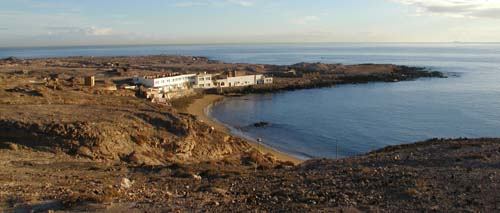
Playa del Cabrón
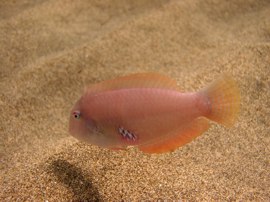
Detta är en rolig dyk till 12m max, den börjar med en kort promenad från stranden, vi följer sedan revet ut mot udden, som utgör naturligt skydd för viken.
Förhållandena här är alltid lugna villset gör denna plats perfekt för nybörjare Samt praktikanter, och de av er som har varit ur vattnet under en längre tid.
Även många erfarna dykare och undervattens fotografer o njuta av viken på grund av mångfalden av liv och goda ljusförhållanden Det finns ett brett utbud av havsliv alltifrån de ständigt närvarande stimen av Atlanten blåfenad frökenfisk, brax, papegojfisk, wrasse, lizardfish och blåsfisk. Flitist sökander kommer att belöna dykaren med musslor, Razorfish, unga barracudor, trumpetfiskar, storögda flundror, stingrockor, bläckfiskar, samt många andra arter. Under våren kommer rovdjur in i viken på natten för att livnära sig på den lekande fisk. En del stannar under dagen ger närbilder av stingrockor, anglesharks, barracuda och vävare fisken
Sikten kommer sällan understiga 15m gör detta till en trevlig lätt dyk full av variation och intresse.
Besöksanläggningar

Eftersom de lokala myndigheterna har begränsat utvecklingen på stranden av den marina reservatet finns inga "besökare" anläggningar alls. Ledsen för det .. men det betyder inte loo eller butiker eller kaféer eller barer. Av denna anledning har vi vårt dykcenter cirka fem minuters bilfärd från dykplatser i staden Arinaga. Vi är faktiskt det närmaste dykcenter den marina reservatet, och den enda PADI och BSAC centrum i Arinaga.
Du kan byta om till upp i våtdräkter i vårt dykcenter, där vi har lokalen! Du kan säkert lämna värdesaker i mitten, eller koppla av i Arinaga på ett av kaféerna mellan dyken. Vi transporterar dig till dykplatsen och tillbaka i en av våra terrängfordon.
Detta gör en dagsutflykt till den marina reserven vid Cabrón med Davy Jones en avslappnad och rolig dag med stor Dykning!
NO Deposit, Cancellation or Change fees!

